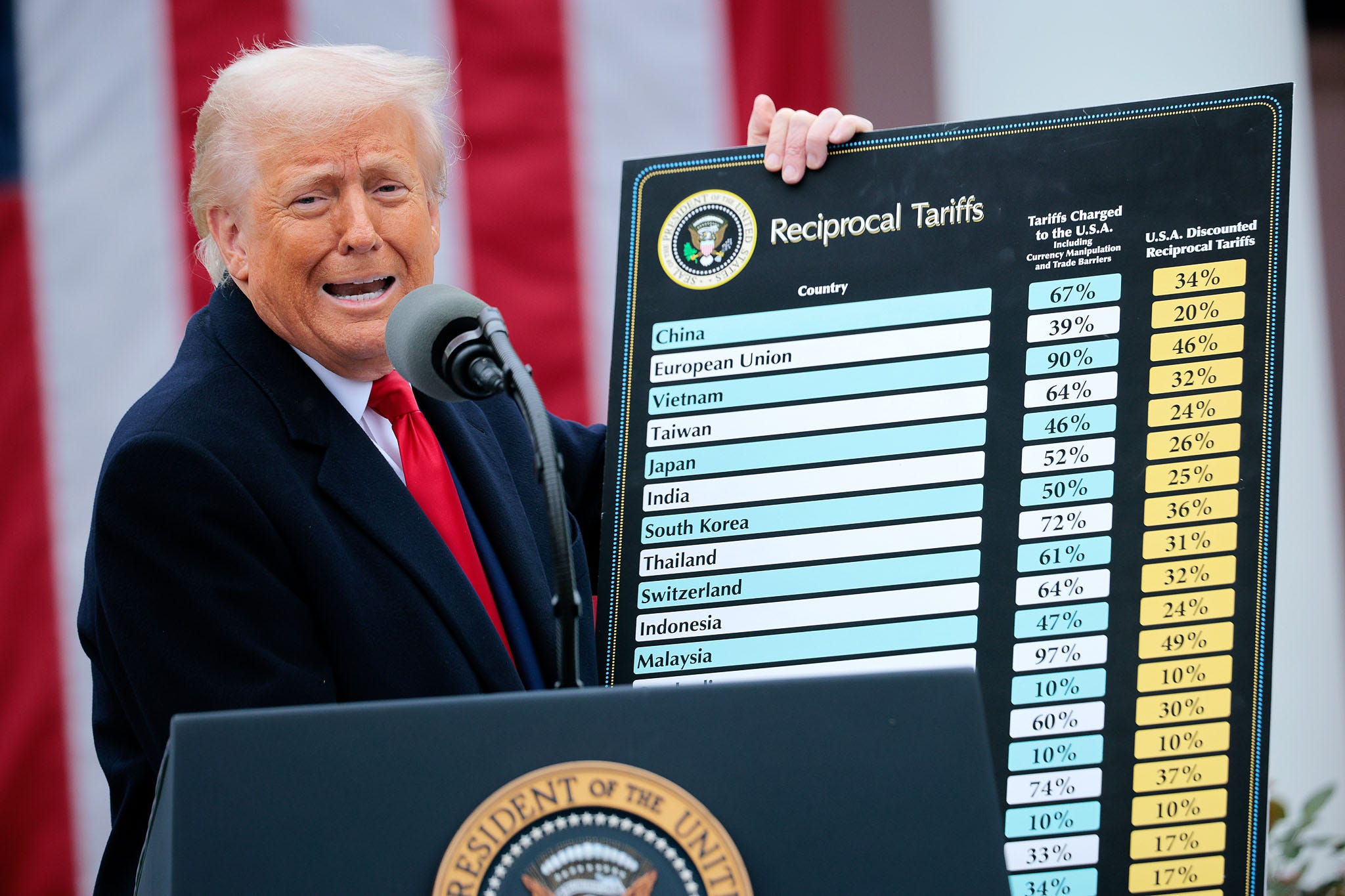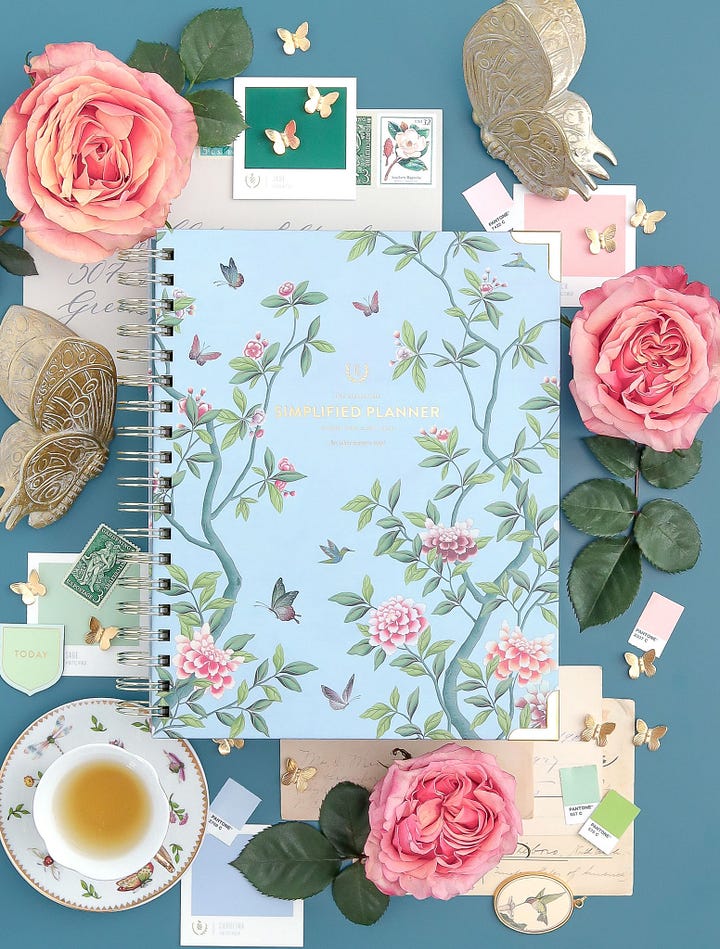What Trump’s Tariffs Mean for One Small Business
Emily Ley, founder of Simplified, breaks down the ‘catastrophic’ consequences.

A slight departure today, friends, but an important one: We need to talk about tariffs. I know, I know — it is easy for one’s eyes to glaze over when it comes to this complicated tax topic. But as conscious consumers, I believe we must take a moment to understand what’s happening.
Last week, President Donald Trump announced a staggeringly high new round of tariffs, causing shockwaves throughout the US financial system. “Tariffs Erase Economy’s Solid Outlook,” read the front page print headline in Monday’s Wall Street Journal, adding“Recession likelihood soars.”
Why the panic? The Daily podcast from the New York Times had a helpful explainer on Friday — “Fear and Fury: The Fallout from Trump’s Tariffs” — which I highly recommend. The Associated Press has a Q&A-style explainer, while CNN has put its primer into infographics.
For me, a conversation with
, the founder of Simplified, drove home the gravity of these tariffs. Many of you know might Ley, a mother of three and author of a new cookbook, from social media (that’s where our paths crossed many years ago). Since 2008, she has been creating beautiful paper goods, including planners designed for busy moms. The future of her Florida-based company, which employs eight other women, is now in jeopardy given what Ley describes as the “catastrophic” fallout from these tariffs.After her above post went viral, I reached out to Ley see if she was willing to break it down for us. What follows is a candid, detailed conversation we had on Friday. To better illustrate how devastating these tariffs will be for her business, Ley shared her production costs and profit margins. She also debunked many myths being reported, including that other countries will foot the bill or that manufacturing can easily be brought back to the US. Ley explains, too, why she joined forces with the New Civil Liberties Alliance and filed a lawsuit against Trump.
What real world impacts are tariffs having in your life? How have you shifted your spending this year? What small businesses are you supporting? Please click below to share.
PS: I will leave this “how to find and contact your elected officials” link right here.
👑 A New Place to Discuss Royal News
Meghan’s new podcast, Confessions of a Female Founder, is slated to arrive this week. I am planning to share my thoughts on the first episode in our Substack chat. Click below and join me there, won’t you? I would love to hear what you think.
The SMT Substack chat, as well as the comments of each newsletter, are open exclusively to paid subscribers. Thank you for your support! You make this work possible. If you haven’t already, please consider upgrading for $5/month.
Small Business Owner Emily Ley on Trump’s Tariffs
Please note: Our conversation has been edited and condensed.
Emily, hi — would you please introduce yourself and share why you started Simplified?
Emily Ley: I founded a company called Simplified in 2008. We make planners and organizational tools for busy women that you can find on our website, as well as little and big stores nationwide, Target, Walmart, places like that. I have nine employees, myself included, all women, and all based here in the United States.
I genuinely started Simplified as a newlywed for fun. I was making stationery and selling it on Etsy, then started getting into more organizational-type things because I needed them in my own life. When my son was born in 2011, I found myself, as many women do, with a lot of things I cared about between work and family. I was feeling very inadequate, keeping up with all of it. I went to Target to find a solution and everything was really overwhelming and complicated. At home, I thought, “Well, I make paper goods. Maybe I could mock up something with Sharpie and a binder?” I made a planner that would house my to-do list and my schedule — and that was it! The Simplified Planner was born.
Tell us how you went from selling stationery on Etsy to finding manufacturers for your products.
In 2012, I produced the first Simplified Planner. The look of it was completely different, it didn’t have all the bells and whistles that ours have now, but it cost me $38 a unit [to make in the US]. And I knew that that wasn’t going to be profitable, but I also was willing to go through the process and learn and see if it stuck or if people were interested. The response was so big that I knew I had to find a way to make it profitable.
I interviewed and researched and looked all over the United States for a manufacturer that could make what I wanted. And everyone in the US either said A) We can’t make that because we don’t have the capability for those different processes or B) If by some stretch we can put together that supply chain, it’s going to cost you a bazillion dollars.
I could have let the dream die right there. Instead I spent a lot of time in the middle of the night Googling. I came across a website where Chinese manufacturers posted about themselves, the types of certifications they have in terms of ethics and inspections, and the types of products they make. I started cold emailing and asking a lot of questions, requesting to purchase samples.
How does one start making goods in a large quantity?
We were trying to bankroll the whole thing [without outside investors]. I have a master’s degree in public administration and worked at the University of South Florida managing the Women in Leadership and Philanthropy program. I had a paycheck from a full-time job and I knew I could work [on Simplified] really hard as a side hustle.
We knew we could only afford to print 500 to start. When I emailed those 10 manufacturers in China, they all wrote me back and said, “Are you missing a zero on your quantity?” I didn’t want to take out a loan to make more planners. I finally found one guy who was willing to take a risk on me. We were able to put together really quality materials. He was amazing, until we outgrew him and went on to a bigger manufacturer.


Can you break down the cost and the profits involved in a product?
The big box stores are different, those are licensed products manufactured through a third party. We make a royalty off of that.
For wholesale, before the tariffs, we were paying around $12 to manufacture each planner.
We make our products for about 25% of what we sell them for at retail. If we sell wholesale to Anthropologie, for example, we sell it [to Anthropologie] at half of the retail price. If a planner costs $54, they are paying half to us and then they are making the profit off the other half.
If your profit is roughly 25% of the retail price, where does that money go?
If I’m making 25% from our wholesale sales, there is still margin there for expenses. A good chunk of it is advertising. We have to pay a lot more in these days to acquire a new customer because of the social media algorithms. We pay for our email platform, our SMS text messaging platform. We pay for a lawyer, we pay for our accountant. We have salaries for a total of nine employees, as well as a philanthropic arm. We give back to organizations that support women and children in need.
Let’s talk about tariffs. What is a tariff and how do you, as a small business owner, pay it?
A tariff is essentially a tax paid on products that are imported into the United States.
The billing has changed over the years but the way it works right now is our manufacturer sends us our invoice. Let’s say we ordered 10,000 planners. The manufacturer would give us an invoice for 10,000 planners and what it costs to make each one. A line item on the invoice would be the tariff per unit. We pay our manufacturers at the time of import, when it hits the port. Then the manufacturer sends the tariff payment to the United States.
“We were forced to pay it and it was so painful, a big blow. We had been growing so organically and beautifully, and all of a sudden we got knocked down.”
When did you start paying tariffs?
During President Trump’s first term, he decided he wanted to impose a 25% tariff on any imports that American companies were importing from China. If we pay $12 for a planner, we are required to pay an additional $3 in tariffs.
The process to put the tariff in place, as outlined by law, is that Congress votes to approve tariffs. This means that everyday people out in the world, including me, can call our representatives and say, “Hey, you’re voting on these tariffs. This is going to negatively impact my company. I can’t afford to pay 25% tariffs. I’m a small business. This is how it’s going to impact me. I won’t be able to hire more people. I’m going to have to cut jobs.”
In the first term, there were multiple waves of tariffs and they took many months to go through Congress. That was what it was. Trump did it properly.
We were forced to pay it and it was so painful, a big blow. We had been growing so organically and beautifully, and all of a sudden we got knocked down and had to find places to pull this from. We couldn’t hire all the people we wanted to hire. We couldn’t invest in the growth opportunities we wanted to do.
As of Jan. 1 of this year, we have paid $1.17 million in tariffs.
Wow — $1.17 million in tariffs. What are the tariffs like in Trump’s second term?
This year, President Trump decided that he is going to circumvent the statutes and do it his own way, pull an emergency lever and say, “I am implementing tariffs.” Congress gets no say.
Our tariffs went from 25% to 45%, then to 54%. We think we might be as high as 79%. We are trying to understand if the tariffs are compounding or replacing each other. It’s being reported in different ways. Even our accountants and attorneys are confused. Trump is not giving a clear explanation. It’s chaos.
As a small business with nine employees, we say, “Ok, this is the hand we’re dealt. Let’s make a plan — just kidding. It’s changed now.”
If it’s 79%, a planner that costs $12 to manufacture would come with a $9.48 tariff — that’s nearly all of your margin?
I don’t know how in the world we’re supposed to navigate this. It is impossible, and it’s devastating.
[EH note: As of Monday, Trump threatened an additional “reciprocal tariff” on goods made in China, pushing the tax Ley estimates she could pay to either 104% or 134%. That would mean a planner that costs $12 to manufacture would cost an additional $12.48 or $16.08 in tariffs — bringing the total cost to more than $24.]
I appreciate how much you are speaking out about this, Emily. Tell us about the lawsuit.
A few weeks ago, I felt very convicted to be a voice of truth in what this actually looks like. I had seen so much misinformation and confusion about what a tariff is and who pays it. We’re being told through a lot of different media and people, including “China is paying the tariffs.” That is not true. I signed the checks.
I posted about it and I got a ton of attention, including media requests. I was also contacted by the New Civil Liberties Alliance in Washington, DC. They were prepared to represent us pro bono. The NCLA is nonpartisan. They are about government overreach. They have gone up against every administration since Trump’s first term. I interviewed them, vetted them, interviewed them again. We had many, many meetings and felt really confident that I was ready to step up and shine a light on the realities of what this is.
Our attorneys are not pro-tariff or anti-tariff. They are pro-law and checks and balances. What Trump did by not going through that months-long process [for congressional approval on the tariffs] was illegal. And that’s our lawsuit. It was filed [last week] in Florida and it hit the news wire like a bomb. My phone is going crazy.
[EH note: In a press release announcing the suit, Andrew Morris, senior litigation counsel for the NCLA, wrote, “By invoking emergency power to impose an across-the-board tariff on imports from China that the statute does not authorize, President Trump has misused that power, usurped Congress’s right to control tariffs, and upset the Constitution’s separation of powers.”]
What do these new tariffs mean for your business?
I will say 25% was really painful as a small business already running on thin margins, 45% was impossible, 54% — let’s just say that’s what it is — is catastrophic.
I would love the opportunity to make our products in America. The supply chain that was created overseas has been formed over decades. And so for people to look at a company like ours and say, “Why don’t you make it here?” That sounds great. But where? We don’t have the infrastructure.
On a human level, it’s devastating. It’s impacting nine women, many of whom are mothers, who work for a company that they love and that they care about. We have these beautiful quality products that we do really good things with. To me, it feels like the death of my American dream and a whole lot of other people’s.
I had an opportunity back in 2008, to say, “I have this really cool idea and I know it’s going to be a journey to make it, but I’m willing to do the work because I know it’s possible.” I feel like I can’t look at my kids now and say, “Anything is possible.” It’s not with all this.
And to those who say, ’Why don’t you raise prices?’
We’ve already raised prices because of tariffs. We absorbed a ton of it. It came out of money we could have been paying employees, we could have been investing in growth, we could have done philanthropic things with. It’s so sad.
I have to say this: I genuinely feel like we all have more in common than not. I follow Jen Hamilton on Instagram, she’s really funny, and she posted something about how we all kind of agree on the “what” of different hot button issues. We don’t all agree on how we get there — and this feels like that. Nobody wants prices to go up. Nobody wants to have to send our stuff overseas to be made. But how do we get there? It’s not this utter dictatorship chaos that’s happening from the top.
“There are three options: Businesses go under, Americans are laid off, or prices go up.”
What does this mean for your big box, licensed offerings?
I wish I knew, to be honest, I don’t know yet. They manufacture all over. They have a huge global presence and negotiating power to say, “We have factories everywhere. We’ll just move.”
Have you considered moving the manufacturing for your wholesale business?
I was talking with my COO about this and she was saying, “When we move manufacturers, it is an absolute full-time job for a year.” It takes a year to interview, get samples, negotiate pricing, make sure these are people we want to work with, make sure they treat their employees well.
We were just looking into other countries and, as of last week, they have tariffs, too.
Would your Chinese manufacturers absorb any of the tariff costs?
That’s a really good question and that is a conversation we’re having. I know they’re not going to eat the whole thing. In the past, they have not eaten the tariff at all. They have been like, “This is between you and your country. This is our price.”
What options do you have right now?
There are three options: Businesses go under, Americans are laid off, or prices go up. And we’re already seeing prices going up.
The other argument I hear is this is a short-term pain for a long-term gain. Small businesses like mine, we can’t survive short-term pain. This is really catastrophic.
How quickly will this impact your business?
We have a product launch next Wednesday, and we’ve decided not to raise prices yet. I genuinely don’t think we can raise prices anymore, but I don’t know where else it’s going to go from.
We have the products in stock but we have extra inventory coming in, which shipped weeks ago. It’s getting here within the next couple of weeks and we will pay for that when it arrives. We will pay whatever this new tariff is then, too. It could be as early as [this] week that we have to pay tariffs.
How are your customers responding? Do you think people understand tariffs and these dire impacts on your business?
I have seen a shift over the last two years. I didn’t start out as a person on the internet that talked about topics like this. I shied away from it because I didn’t want to deal with the backlash or the debate that had to happen around it. When I did start sharing my genuine feelings a few years ago, it was very volatile in the comment section. It was 50/50, what people felt about policy or who’s in office or rights that people do or do not have. In the last few years to the last few months, it’s not that divided anymore. A couple people pop off about “You should make it here, and I don’t understand why you don’t.” But overall it is very much: “We support you.”
When I shared the lawsuit, the comment section made me cry. It was so supportive. One lady wrote, “My launch day budget for next week tripled.” Another lady was like, “I forgot to buy my 2025 planner, and I just bought one because I believe in what you’re doing.” At the end of the day, I think we’re all more alike than we are different. People are putting their dollars where their hearts are.
What can we do to help?
People these days are aligning their dollars with their values more than ever. And I know I’m trying to, I’m not perfect at it, but I’m trying to make sure where I spend is a place I want to have my dollars. The way that you support small businesses right now is to shop them!
Also, I’ve told everyone that the kind words on Instagram — sharing and making sure your friends and neighbors understand how tariffs work in a friendly and respectful way — is a lot and we really appreciate it.
My sincere thanks to Emily for sharing. You can find her on Instagram at @EmilyLey and on Substack at
. Shop the new Simplified drop this Wednesday, April 9 . I cannot wait to buy her new offerings — vote with your wallets, friends!












Elizabeth, I can't thank you enough for allowing me to share our story in this special place. Your Substack (and book!) are favorites of mine and many people I know. The work you do matters in tremendous ways.
This is such a devastating and necessary conversation. I’m also a small business owner (service, not product, so I’m spared some of the tariff effects) but I can’t imagine losing what I worked so hard to build because of a racist, incompetent, capricious and cruel government. I’m so sorry, Emily. I don’t have anything else to say except that I’m so, so sorry. This is insane and pointless and horrifying.
(To be clear, I didn’t vote for this. I actively campaigned and door knocked and called and texted and sent postcards for Kamala.)